The most notorious idol worship in ancient Israel was the Molech. It was so terrible that it “merits” its own description in the Mishnah:
The Molech was already forbidden in the Torah:
“And I will set My face against that party, whom I will cut off from among the people for having given offspring to Molech and so defiled My sanctuary and profaned My holy name.” (Vayikra 20:3)
Even King Solomon was not immune to its siren song:
“At that time, Solomon built a shrine for Chemosh the abomination of Moab on the hill near Jerusalem, and one for Molech the abomination of the Ammonites” (Kings I 11:7)
Molech worship seems to have reached its apogee in the time of the last kings of Judah. It was practiced by Ahaz (Chronicles II 28:3) and Menashe (Chronicles II 33:3) and Jeremiah railed against it in his prophecy:
“and they built the shrines of Baal that are in the Valley of Ben-Hinnom, where they offered up their sons and daughters to Molech—when I had never commanded, or even thought [of commanding], that they should do such an abominable thing, and so bring guilt on Judah” (Jeremiah 32:35)
Much ink has been spilled over what Molech worship actually was and where it originated; our Gemara also has different opinions about it. But what is clear from the mentions of Molech in the books of Nach is that it is practiced in a particular place: the Valley of Ben Hinnom (Geh Ben Hinnom) in Jerusalem:
“He also defiled Topheth, which is in the Valley of Ben-Hinnom, so that no one might consign their son or daughter to the fire of Molech” (Kings II 23:10)
Jeremiah even goes so far as to say that because this valley is the center of the evil cult, the valley’s name itself will be changed from the innocuous Ben Hinnom’s Valley to Valley of Slaughter:
“Assuredly, a time is coming—declares God—when this place shall no longer be called Topheth or Valley of Ben-Hinnom, but Valley of Slaughter.” (Jeremiah 19:6)
Ironically, this is not what happened. Instead of the valley losing its name, that name, shortened, became the Jewish name for Hell: Geh (ben) Hinnom. This was not only metaphorical; in a fascinating discussion about Heaven and Hell in Eruvin, we learn that the entrance to Hell is actually in Geh ben Hinnom
“Rabba bar Maryon who taught in the name of the school of Rabbi Yoḥanan ben Zakkai: There are two date trees in the valley of ben Hinnom, and smoke rises from between them . . and this is the entrance to Gehinnom.” (Eruvin 19a)
Where is this valley and what do we know about it? The ancient city of Jerusalem is surrounded by two major valleys: the Kidron on the east and the Hinnom on the south and west:

Zero0000, CC BY-SA 4.0 <https://creativecommons.org/licenses/by-sa/4.0>, via Wikimedia Commons
The north is the only side of the city not protected by a natural border and therefore it is the most vulnerable to invasion:
“And God said to me: From the north shall disaster break loose upon all the inhabitants of the land!” (Jeremiah 1:14)
As we have seen, the valleys outside the city were the main place for idol worship, although we do hear about even more egregious violations, where idols were present even in the Temple itself:
“Then the king ordered the high priest Hilkiah, the priests of the second rank, and the guards of the threshold to bring out of the Temple of GOD all the objects made for Baal and Asherah and all the host of heaven.” (Kings II 23:4)
Jerusalem was a compact city with room only for homes and royal and religious institutions. Anything else, from the practical, like farming, to the profane, like altars for idols, needed to take place outside the city. However, the most significant use of the valleys, one that we can still see today, was for burial.
Walking in the Ben Hinnom Valley today it is hard to picture the scenes of cruelty and debauchery described by the prophet Jeremiah. It is pastoral, quiet and lovely. However, it is very easy to see the remains of burial caves. The Hinnom Valley was used for burial purposes up to and including modern times; the Karaite community still uses it today and the Protestant cemetery on its eastern slope is famous for being the final resting place of Oskar Schindler.The oldest caves date back to late First Temple times (sixth century BCE). These are found on the western slope (Ketef Hinnom), today these graves are between the Begin Center and the Scottish Church. The caves, excavated in the 1970s, yielded one of the most exciting finds in Biblical archaeology. Dr. Gabi Barkai, with the assistance of an intrepid child helping at the dig, discovered a silver amulet with the oldest Torah text ever discovered – most of the priestly blessing written in Bamidbar chapter six.
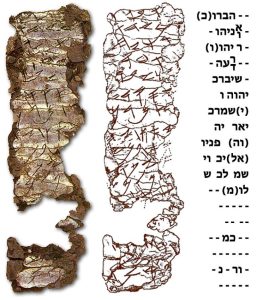
Tamar Hayardeni, Attribution, via Wikimedia Commons
Down in the valley, if you walk towards where the Hinnom meets the Kidron, it is impossible to miss the many burial caves along the way. Most of them are from Second Temple times and have nothing in them anymore but they tell us that this was the place to be buried if you were wealthy enough to afford a family burial cave.
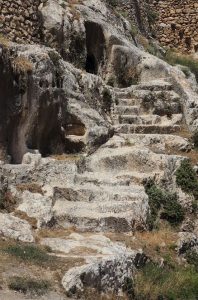
Yakov Aflalo, CC BY-SA 3.0 <https://creativecommons.org/licenses/by-sa/3.0>, via Wikimedia Commons
Above on the slopes is the Karaite cemetery, still used today. On the opposite slope, below Mount Zion, is what is known as the Sambusky cemetery. This was a burial ground for the paupers of Jerusalem. It was also the place where the contents of the Genizah, including Torah scrolls that had deteriorated, were buried after a festive procession from the Old City. The cemetery was in terrible disrepair for many years and had basically become a garbage heap but the devoted efforts of the late Doron Herzog and the City of David restored it and today it has a proper gate and it has been cleaned up.
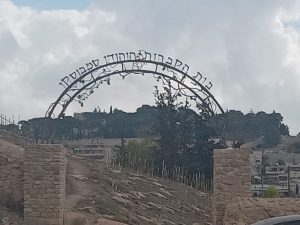
Shulie Mishkin
At the edge of the valley, where it meets the Kidron, is a building on the slope known as the St. Onuphrius monastery. This Greek Orthodox structure is built on the place that is known by Christians as Akeldama, the field of blood. According to the Gospels, this is where Judas Iscariot was buried, or alternately where his “blood money” for betraying Jesus was used to buy a plot to bury the poor. In either case, it continues our theme of burial. The monastery is built around ancient Second Temple burial caves.
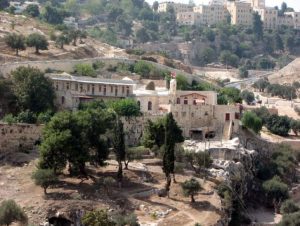
מיכאלי at Hebrew Wikipedia., CC BY-SA 2.5
Today the Hinnom Valley is undergoing a restoration. The City of David is working to make it a place that is visited by tourists and so they have built two new attractions. One is the “Farm in the Valley,” a beautiful spot where you can see and participate in techniques of ancient agriculture. The other is a suspension bridge above the valley that affords amazing views, even though it has been criticized as a bridge “from nowhere to nowhere.”
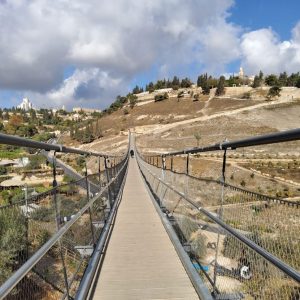
Dr. avishai teicher Pikiwiki Israel, CC BY 2.5 <https://creativecommons.org/licenses/by/2.5>, via Wikimedia Commons
The Hinnom Valley has seen death, debauchery and evil but today it is one of the most picturesque places in Jerusalem. What would Jeremiah say?
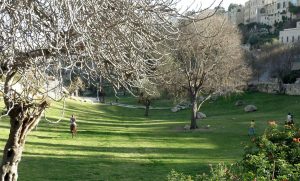
RonAlmog from Israel (ישראל), CC BY 2.0 <https://creativecommons.org/licenses/by/2.0>, via Wikimedia Commons










